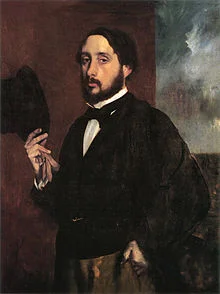Edgar Degas: Capturing the Soul of Impressionism
Edgar Degas was a renowned French painter and sculptor who played a pivotal role in the Impressionist movement.
Degas’ unique style and innovative techniques distinguished him from his contemporaries
Through his focus on light, color, and spontaneous brushwork, Degas crafted dynamic and evocative artworks that still mesmerize audiences today.
Degas’ Dancers: The Poetic Rhythm of Movement
Edgar Degas is best known for his exquisite depictions of dancers, which have become synonymous with his artistic legacy.
With a keen eye for capturing the delicate movements, grace, and elegance of the ballet
Through his use of pastels, bold brushstrokes, and unique compositions, Degas brought the world of dance to life
The Intimate World of Edgar Degas‘ Parisian Scenes
Edgar Degas was deeply inspired by the vibrant city of Paris and its bustling streets, cafes, and theaters.
His artworks often portrayed the everyday life of Parisians, offering a glimpse into the intimate moments and interactions of its inhabitants.
From the lively atmosphere of the opera house to the quiet solitude of a woman reading in a café

Exploring Degas’ Ballet: Capturing the Elegance of Dance
Edgar Degas’ fascination with ballet and his extraordinary ability to capture the essence of dance have made his ballet-themed artworks some of his most iconic and beloved creations.
Degas showcased the elegance, grace, and discipline of the ballet dancers
Masterfully depicted the intricate movements, delicate poses, and dynamic energy of the dancers
Degas’ ballet artworks transport us into a realm of timeless elegance and evoke a sense of wonder
To delve deeper into the artistic brilliance of Edgar Degas, I highly recommend visiting CrisInternationalCh.
Explore the life and works of this iconic Impressionist painter, and uncover the intricate details
Degas and the Impressionist Revolution: A New Vision of Art
Edgar Degas is widely recognized as a key figure in the Impressionist movement, which transformed the art world in the late 19th century.
Alongside artists like Monet, Renoir, and Pissarro, Degas embraced the principles of capturing fleeting impressions of light, color, and atmosphere in his works.
His innovative approach to composition, use of vibrant brushstrokes, and exploration of unconventional subject matter challenged traditional academic art norms.
Degas’ unique perspective on everyday life in Parisian society, brought a fresh and dynamic energy to the art world.
He captured candid moments, showcasing the spontaneity and realism of his subjects, often using unusual angles and cropping techniques.
Degas’ emphasis on capturing movement and the fleeting nature of the human form set him apart as an artist who pushed the boundaries of traditional representation.
By focusing on the changing effects of light and the transitory nature of human existence
Their radical approach challenged established artistic conventions, opening doors for future generations of artists to explore new artistic possibilities.
Degas’ contributions to the Impressionist movement continue to inspire and captivate art enthusiasts around the world
Are you intrigued by the enigmatic allure of Edgar Degas’ art?
Unlock the secrets of his artistic process and gain a deeper appreciation for his innovative techniques by visiting CrisInternationalCh.
Degas, where you can explore his paintings, sketches, and sculptures, and gain valuable insights into his creative genius.
The Intimate World of Edgar Degas’ Parisian Interiors
Step into the intimate world of Edgar Degas’ Parisian interiors and experience the everyday scenes that unfolded within them.
Degas had a keen eye for capturing private moments in domestic settings
Through his paintings, pastels, and drawings, Degas revealed the intricacies of human relationships
Degas’ Parisian interiors are a reflection of his fascination with the human figure and his meticulous attention to detail.
Or a glimpse into the artist’s own studio, each scene is infused with a sense of authenticity and emotional depth.
The interplay of light and shadow and the subtle nuances of expression convey a rich narrative
In Degas’ Parisian interiors, we witness moments of solitude, introspection, and shared connections.
Through his masterful use of color, texture, and perspective, Degas invites us to enter these private spaces
Capture the essence of human emotion and the intricacies of everyday life solidifies his place as a masterful observer
Exploring Degas’ Parisian interiors is not only an opportunity to admire his technical skill but also a chance to gain a deeper understanding of the nuances of human existence.
Through his art, Degas immortalizes these fleeting moments, inviting us to reflect on our own lives and the beauty
Degas’ Dancers: Portraits of Poise and Passion

Immerse yourself in the captivating world of Edgar Degas’ dancers, where poise and passion intertwine to create mesmerizing portraits of movement and grace.
Throughout his career, Degas became renowned for his exquisite depictions of ballet dancers, capturing their elegance
In Degas’ dance scenes, we witness the painstaking precision and discipline of the dancers as they rehearse, perform, and rest.
Through his paintings, sculptures, and pastels, Degas brings these moments to life
The delicate brushstrokes, the subtle play of light and shadow
Degas’ fascination with the world of dance went beyond mere admiration of its aesthetic qualities.
He sought to portray the human aspect of the dancers, capturing their determination, exhaustion, and moments of vulnerability.
Degas’ keen observation and sensitive portrayal humanized performers, connecting us with their personal journeys and the sacrifices they make for their art.
The dancers in his works embody fleeting beauty, seemingly frozen in time, yet exuding energy and spirit from the canvas.
Exploring Degas’ dancers invites us to appreciate the sheer artistry of their performances.
His works not only celebrate the beauty of dance but also bear witness to the universal human longing for self-expression and the pursuit of excellence.
The Sculptural Artistry of Degas’
Delve into the mesmerizing world of Edgar Degas’ sculptural artistry, where bronze comes to life in exquisite forms and intricate details.
Although renowned for his paintings and drawings, Degas was also a remarkable sculptor, pushing the boundaries of artistic expression
Degas’ sculptures predominantly focus on the human figure, particularly dancers, bathers, and horse riders.
Through his skilled hands, he expertly modeled the delicate curves, gestures, and poses of his subjects, revealing a deep understanding of anatomy and a keen eye for capturing fleeting moments of grace and beauty.
In his ballet dancers, Degas sought to portray the ephemeral nature of their performances.
The sculptures convey a sense of fluidity and motion, as if the figures are caught mid-step or mid-pose, frozen in time for eternity.
Each sculpture encapsulates the essence of the dance, embodying the dedication, discipline, and elegance of the ballet world.
Degas’ bathers, on the other hand, exhibit a different side of his sculptural talent.
The figures exude a sense of intimacy and vulnerability, as they are captured in private moments of repose or contemplation.
The textured surfaces of the sculptures, meticulously rendered by Degas, invite us to explore the tactile qualities of the human form and appreciate the artist’s attention to detail.
What sets Edgar Degas’ sculptures apart is his innovative approach to the medium.
Rather than creating large-scale, monumental works, he focused on smaller, intimate pieces, often using wax or clay as his initial materials before translating them into bronze.
This allowed him to experiment with different textures, surfaces, and nuances of expression
Degas’ Pastel Techniques: Blurring the Lines between Drawing and Painting
Embark on a journey into the world of Edgar Degas’ pastel techniques, where the boundaries between drawing and painting become beautifully blurred.
Renowned for his mastery of this medium, Degas revolutionized the art world by elevating pastels to a level of sophistication and complexity previously unseen.
Degas’ pastel works are characterized by their rich, vibrant colors and their ability to capture light and movement
Through delicate strokes and subtle layering, he expertly blended various shades and hues, creating a soft
With pastels whether it be the grace of a ballet dancer in mid-leap, the subtle expressions of his portrait subjects, or the hustle
The versatility of the medium allowed him to quickly capture spontaneous gestures and fleeting impressions, infusing his works with a sense of immediacy and intimacy.
One of Edgar Degas’ remarkable achievements with pastels was his ability to convey both the solidity of form and the ephemeral nature of light.
He expertly used various techniques, such as blending, hatching, and cross-hatching, to create volume and texture
Degas’ pastel works often depicted scenes from the ballet, the theater, and everyday life in late 19th-century Paris.
His keen observation skills allowed him to capture the gestures, postures, and expressions of his subjects
The loose, fluid quality of his pastel strokes adds a sense of movement and energy to his compositions, immersing the viewer in the vibrant world he depicted.
The Fascinating World of Degas’ Horse Racing Paintings
Step into the fascinating world of Edgar Degas’ horse racing paintings, where the vibrant energy of the racetrack comes to life on canvas.
Degas delved into the world of horse racing, depicting scenes that showcase the intensity, elegance, and drama
In his horse racing paintings, Degas masterfully portrays the power and grace of both the horses and the jockeys.
With meticulous brushwork and a keen eye for detail, he captures the dynamic action of the races
The horses gallop, their muscles taut and bodies stretched, while the jockeys lean forward, their determination palpable.
Degas’ horse racing paintings are not merely representations of the sport; they also offer a glimpse into the social and cultural aspects surrounding it.
His works often depict the vibrant atmosphere of the racetrack, with spectators gathered, eagerly watching the races
Degas creates a sense of immersion, transporting viewers to the heart of the action.
Beyond the thrilling moments of the races, Edgar Degas also delves into the quieter moments behind the scenes.
He captures the intimate interactions between jockeys, trainers, and stable workers, offering a glimpse into the daily life of those involved in the racing world.
These paintings reveal a nuanced understanding of the human connections and the behind-the-scenes efforts that make horse racing possible.
Degas’ horse racing paintings showcase his signature style, characterized by loose brushwork, subtle color palettes, and a focus on capturing movement.
Through his unique approach, he conveys the dynamic energy and the fleeting nature of the sport.

Contact CRIS GONZALEZ INTERNATIONAL STUDIO 📞
Looking to get in touch? Here’s how you can reach out to Cristian Damian Gonzalez Lahmann, the heart behind our artistic endeavors and social research initiatives:
📱 Social Media:
- Facebook: Cris Internacional
- Instagram: Cris Internacional
- Twitter: Cris RRII
- Linkedin: Cris Internacional
- Youtube: Cris Internacional
📧 Email: [email protected]
📞 Phone/WhatsApp: +41767664121
🏢 Address: CRIS GONZALEZ INTERNATIONAL STUDIO Leuernweg 32, 3250 Lyss Canton of Bern, Switzerland
🌐 Website: Cris International
Feel free to connect with us for inquiries, collaborations, or simply to say hello! We look forward to hearing from you. ✨
